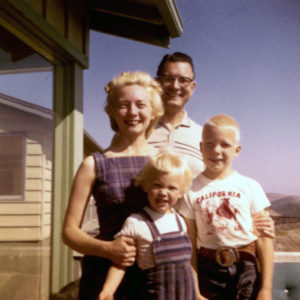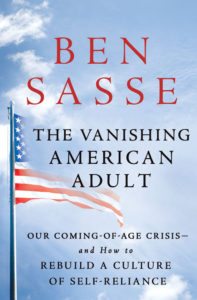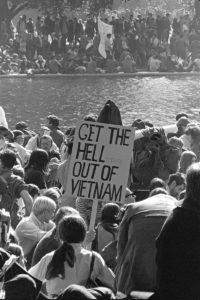by Ben Sasse
How did we get to this point—where a large portion of our people in the prime of their lives are stuck in a sad sort of limbo, ordering pizza on cell phones while streaming Netflix from their parents’ basements, where they live? There is no simple answer, but we can wrap our minds around the current unraveling of adolescence by briefly considering five big developments in the United States in the first decades after World War II.

First, although the echoes of the 2008 recession remain and longer-term employment instability will likely accelerate, we still have more material surplus than any other people any place in all of history. That’s obviously good news—but it also has a large and under discussed downside: our jaw-dropping wealth accumulation over the past seventy years has allowed America’s youth to indulge in more creature comforts than any generation ever before.
Second, and related to our over consumption, our kids no longer know how to produce. They don’t grow up around work. Today’s children are likely to conceive of work as one job, and yet less likely to work the same job as their parents—such as on a family farm or ranch or in the same trade—than ever before. They no longer see up close a broad range of their parents’ work struggles, and they do not daily observe their parents’ work ethic the way their great-grandparents did. Most kids’ hours are spent chiefly in age-segregated environments.
This vacuum of adult authority and of the compulsory nature of work has been filled first by the peer culture of the school and more recently by the narcissistic autonomy of the digital world. Ironically, even though many late teens and twenty-somethings continue sleeping physically under their parents’ roofs for longer than they did in past generations, they have been liberated from the social and moral universes of their elders much earlier.
Third, the warning bells we’ve been hearing for half a century about the nuclear family being in peril turned out to be right. A stunning portion of our kids now experience the disruption of home life, one that rattles the stable, trusted environment from which they should be finding an orderly launch into independent adulthood. Daniel Patrick Moynihan, the legendary New York Democrat (whose desk I occupy on the U.S. Senate floor), first sounded the alarm about the crisis of black family disintegration. The U.S. Department of Labor published Moynihan’s report on why federal officials should panic about household collapse in 1965.
At the time, the crisis was an out-of-wedlock birthrate among African Americans rocketing toward one in four, compared with a rate in the low single digits for whites. Five decades later, it’s clear that the problem isn’t about race—it is nearly universal. The works of Charles Murray, Robert Putnam, and J. D. Vance show that these tragic developments are not unique to any geographic or ethnic community. The share of white births occurring outside marriage is now roughly three in ten, which is higher than the “emergency” black rate in the 1960s. And although the teen pregnancy rate is down, the Urban Institute’s “Moynihan Report Revisited” pegs the overall share of black births now occurring outside marriage at more than seven in ten.
Fourth, we have unhelpfully come to so identify our obligations to teenagers with the institution of secondary schooling that we have lost the collective memory of folks who came of age without schooling as the defining formative institution in life. (Note: this was essentially everyone, everywhere, until a century ago.) In most states, year-round secondary schooling went from being voluntary in the 1910s to being a compulsory and near-universal experience by the 1940s.)
While this obviously brought about much good, an unintended consequence has been that institutionalized schooling displaced work and other multi generational environments as the context and the culture in which coming of age occurred. Even just after World War II, almost all American families still had many older voices around the dining room table that could—by their own experience—broaden a conversation about growing up to more than just progressing through annual grades in school.
brought about much good, an unintended consequence has been that institutionalized schooling displaced work and other multi generational environments as the context and the culture in which coming of age occurred. Even just after World War II, almost all American families still had many older voices around the dining room table that could—by their own experience—broaden a conversation about growing up to more than just progressing through annual grades in school.
Somewhat paradoxically, even as schooling swallowed most of our mental image of education, it also became shallower in the 1970s and beyond. Some of this evolution toward more secular, bureaucratic schooling followed necessarily from the Supreme Court decisions prohibiting school prayer and religious instruction in the 1960s. Regardless of whether you believe children should have prayer or study religion in school, the removal of those activities had the unintended consequence of removing existential questions about how the individual fits into the bigger, cosmic picture; about our life’s purpose.
The moral hollowing of schooling is also attributable to the erosion of secondary education’s previously secure place and purpose in preparing kids for steady jobs right after graduation. Education historian Paula Fass traces the drift toward the “warehousing” of our young to schools’ loss of their tangible, culminating purpose—to prepare the emerging generation for conclusive entry into adult productivity. Instead, “going to high school became a stop-over during the teen years, with very little to offer beyond academic selection for those who would go on to college . . .”
When a diploma was no longer a predictable ticket to a fulltime, middle-class job and a set of expectations about adulthood, high schools began to fray. Peer culture metastasized to fill the vacuum of purpose. Instead of learning how to behave from their teachers, who no longer really

saw their jobs as moral instruction and instilling wisdom acquired through age and experience, kids were learning how to behave from other kids, with predictable results.
Fifth, the protest era of the 1960s saw an atypical amount of conflict about what America means, about whether our experiment in self-governance was really all that special. Some of the struggles—chiefly civil rights—were essential to America’s finally living up to the Declaration of Independence’s vision of universal, color-blind human dignity. The nation was centuries overdue in living up to our ideals that all men and women, of all races, are created equal. Other struggles, however— such as debates about the morality of different wars, about the costs of drug use, about the prudence or pointlessness of sexual boundaries—we yelled about for a while, and then we stopped yelling, but not because we came to agreement.
Tragically, we quasi-decided instead not to finally decide, not to reconcile. In essence, as the late 1960s eventually became the early 1980s, we navigated some big cultural bumps not by deliberating together and then actually forging a new consensus, but instead by allowing polarization to hollow out much of our discourse. We permitted popular culture and the trivial to substitute as the basis of our shared experience.
To be sure, there remained sparks of renewal in our national consensus: we would eventually resolve to win the Cold War together; our tremendous progress on racial inclusion was overwhelmingly if not unanimously celebrated; the broader inclusion of Catholics and Jews into a previously Protestants-first culture became the norm; and we went to the moon. Nonetheless, national consensus on goals and shared ideals that could unite this diverse nation continued to fray beyond the 1960s.
Looking back, the unprecedented consumption, the decreasing presence of work in the lives of young people, and the more frequent broken homes of that turbulent decade mark an epochal divide in the experience of American adolescence. Arguably the most fundamental cleavage in American life is between those who came of age after rather than before the Baby Boom.
U.S. Senator BEN SASSE is a fifth-generation Nebraskan. The son of a football and wrestling coach, he attended public school in Fremont, Neb., and spent his summers working soybean and corn fields. He was recruited to wrestle at Harvard before attending Oxford and later earning a Ph.D. in American history from Yale. Prior to the Senate, Sasse spent five years as president of Midland University back in his hometown. As perhaps the only commuting family in the U.S. Senate, Ben and his wife, Melissa, live in Nebraska but are homeschooling their three children as they commute weekly back and forth to Washington, DC.
